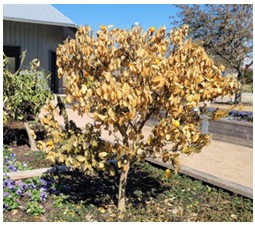Patience is Key to Gardening After the Freeze
Stephen Brueggerhoff, CEA – Horticulture; Texas A&M AgriLife Extension Service
3/1/2021
The recent winter storms that held Texas in its grip has had a severe effect on our landscape plantings, orchard, and vegetable gardens. After witnessing how quickly our landscapes were affected, our instinct is to take immediate action by pruning, fertilizing, and watering, practices that are based on annual cultural and seasonal activities. My colleagues and I are advocating to take a step back, to wait until your plants finish responding to the event prior to taking immediate action.
Pruning affected vegetation is the first question clients make when calling my office in the aftermath. While this is a normal response to landscape challenges, it is not always the best practice and depends on the severity of plant damage and stage of regrowth or decline. Our first step is to assess the damage as each plant will very in response. While southern magnolia trees around my neighborhood kept their foliage and did not appear to be immediately affected, over time the leaf margins may begin to look burned, and tissue could further decay. The leaves may ugly but does not warrant leaf or stem removal. The leaves on my citrus trees wilted within a day, then slowly faded and turned brown and have not separated from their stems.  This type of decline informs me that the vascular tissue is affected and has been damaged to the point of disrupting translocation of water and nutrients to the stems and leaves. Within two weeks, stem tissue in the outer canopy of my citrus continues to decline. Pruning at this stage is akin to chasing a rabbit, and our instinct to prune into seemingly living tissue at this time can be counterproductive. There may be viable tissue within the stems or trunk of the plant that will naturally express growth after stress, and pruning could remove potential new growth. Also, pruning is a stressor on plants and can initiate tender growth that may succumb to a late season freeze. Best practice is to wait until the plant naturally expresses vegetation to target pruning points above the new growth. Some plants, like rose varieties, may be developing new growth at buds that provide a visual cue for pruning and retaining the plants’ natural form.
This type of decline informs me that the vascular tissue is affected and has been damaged to the point of disrupting translocation of water and nutrients to the stems and leaves. Within two weeks, stem tissue in the outer canopy of my citrus continues to decline. Pruning at this stage is akin to chasing a rabbit, and our instinct to prune into seemingly living tissue at this time can be counterproductive. There may be viable tissue within the stems or trunk of the plant that will naturally express growth after stress, and pruning could remove potential new growth. Also, pruning is a stressor on plants and can initiate tender growth that may succumb to a late season freeze. Best practice is to wait until the plant naturally expresses vegetation to target pruning points above the new growth. Some plants, like rose varieties, may be developing new growth at buds that provide a visual cue for pruning and retaining the plants’ natural form.
While fertilizer applications are generally applied to ornamental and fruit trees at this time of year, root systems may have been compromised and water-soluble salts in fertilizer can place stress on the plantings, especially fertilizers with a higher percentage of nitrogen often used in orchard management. The foliage of all citrus trees in our demonstration garden orchard has been severely affected, with entire canopy defoliating on some varieties. As mentioned, I will need to wait for regrowth regarding pruning and will target mid-May to assess the tree health prior to making the first annual fertilizer application. I am certain your lawn has been affected by the extreme temperature, and reminder that the best fertilization practice is when the grass is actively growing and in early April, or after the second spring mowing.  Some homeowners may traditionally apply pre-emergent herbicides at this time of year to suppress spring weeds, and Turfgrass Specialist Dr. Chrissie Segars recommends discontinuing application and related to this past event. The mode of action of these kinds of herbicides suppresses root growth of weed seeds. Our turfgrass is already stressed, root systems potentially have been compromised and use of pre-emergent herbicides will inhibit recovery.
Some homeowners may traditionally apply pre-emergent herbicides at this time of year to suppress spring weeds, and Turfgrass Specialist Dr. Chrissie Segars recommends discontinuing application and related to this past event. The mode of action of these kinds of herbicides suppresses root growth of weed seeds. Our turfgrass is already stressed, root systems potentially have been compromised and use of pre-emergent herbicides will inhibit recovery.
It is emotionally difficult to witness damage to our beloved plants and remember that patience is a virtue that will benefit your garden in the long run. Brazoria County Master Gardeners are hosting our 3rd online plant sale March 27 and 28, where you can choose ornamental landscape plants and select summer vegetables for your gardens. More information and a list of plants will be available as it develops from the BCMGA website: txmg.org/brazoria/. I am kicking off my Urban Orchard Series workshop on March 20, starting with best pruning practices for peaches, pears, and citrus. Registration will be available soon on our county website: brazoria.agrilife.org/. Finally, I encourage each community member to explore Texas Speaks, an online survey conducted by Texas A&M AgriLife Extension Service with the purpose of listening to Texas citizens as they identify the strengths and needs of their communities. To participate browse online: tx.ag/texasspeaks. Thank you for the opportunity to serve your needs, and I will see you in the garden.
